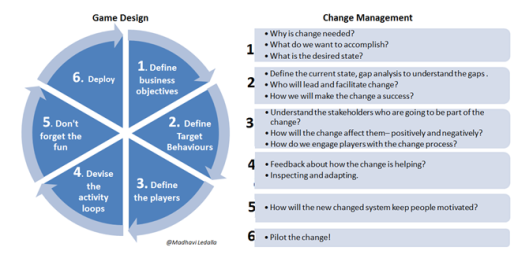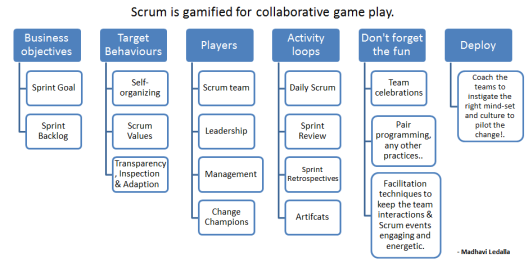This is a guest post by Madhavi Ledalla.
Introduction to Gamification
I have been studying about Gamification for a while and after having been part of several change initiatives, I started appreciating how the game design concepts can be used for change initiation and management. Gamification involves using game design elements in non-game design contexts. Gamification plays a very key role in increasing the employee engagement. The gaming elements and concepts behind the game design framework used to inspire people to get to the next level of the game play can be applied to non-gaming context as well to engage and motivate teams to reach to the next levels as deemed by the organizations.
There are many games in the industry which use simple game mechanics that include extrinsic rewards like badges, points etc. However the versatility of a gamified system depends on how the intrinsic motivators are exploited by providing real-time feedback to the players to reinforce the desired behavior. The key success of a gamified system is based on how effectively the gaming elements are used for engaging, rather than a means of showcasing extrinsic rewards. The desired outcome of a gamified system directly correlates to the motivation of the players involved. The idea of gamification and the universality of its application bring in a completely different dimension of thinking!
Game Design Framework:
The game design process typically goes through six steps as cited by “Kevin Werbach”, which are detailed below:

Now let us try to understand the typical steps involved in Change management and then look at how game design steps can be used as a tool for change management.
Change Journey steps:
Any general change initiative whether it relates to agile transformation or not requires the following activities to be done at a minimum in most of the cases, though there could be exceptions depending on the context and organizations.
- Identify the need for charge and define the desired state?
- How will it affect the organization, leadership and teams?
- Assess the organization readiness for the change?
- Figure out who will lead the change?
- How will the change initiative be facilitated?
- How will the change participants be engaged and motivated?
- Initiate the change.
- The communication strategy.
- Inspect and adapt the change initiative based on the feedback.
Change Management and Gamification
Having said this, I think that the game design process steps can be mapped to a change management process. In fact, the game design process may be used as a change management tool depending on the context, though it may not be applicable always. Here is how I see them both map to each other as shown below.

Having worked with a couple of agile transformation initiatives, I think the game design process steps can be used to initiate agile transformations too as it is all about change management.
Gamification and Scrum
There are several agile frameworks like Scrum Kanban, XP that can be used at the team level during the delivery and execution, depending on the context and the problem domain. I have been using Scrum from few years, and was thinking of doing something different to create more engagement and fun! Since I was reading on gamification, I thought why not I gamify the Scrum framework! As I started working on it, I was surprised to appreciate that Scrum is already gamified to a larger extent as I describe it below.

Scrum can be considered as a collaborative game play framework where team members engage with each other every sprint to deliver business value. Any game should have clear goals and rules- and every sprint has this. The gaming environment must provide constant feedback that helps players change their strategy all along the way and the sprint ceremonies are in fact meant for this! The ceremonies and artifacts in Scrum are nothing but the activity loops. For example, the burndown charts, Task boards- Daily progress indicators, Definition of Done, frequent feedback from Product Owners during the sprint, are typical examples of engagement loops used in a gamified system. Similarly the Sprint reviews, retrospectives, release burndown/burnup charts can be considered as examples of progression loops in a gamified system.
In my opinion, I think the concept of basic gamification is already embedded in the Scrum Framework to an extent. This is my comprehension based on what I read and understood about gamification, while I was figuring out avenues to apply this concept to Scrum teams. However there is always a scope to add more elements to gamify the existing framework by using customized information radiators to maximize the team’s engagement by providing lots of feedback that will help them look at the current state and inspect and adapt!
My two cents
I would summarize by saying that we can always gamify the existing system to make it engaging by using data analytics, visual radiators, maturity levels and feedback loops. A word of caution is that too much focus on extrinsic motivators like the points, badges, rewards, levels may lead to teams getting pressurized to attain levels and may end up in misusing the gamified system and eventually start playing with the numbers!
Would be glad to hear from readers if any of you tried gamification while working with teams! Looking forward to learn from your experiences!
If you are interested in Agile, you can read more here.If you would like to submit an article in SIPM, please send your article at Steppingintopm(at)gmail.com with the email titled as "blog article submission".














